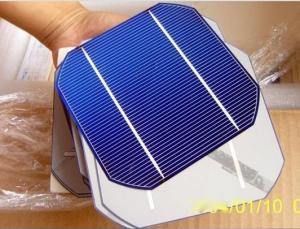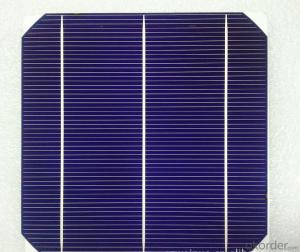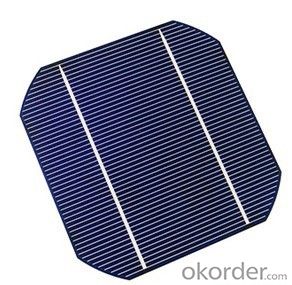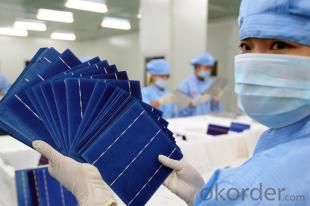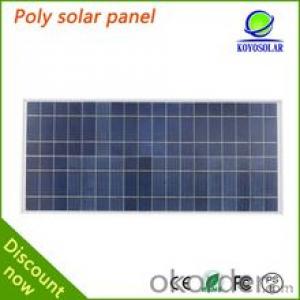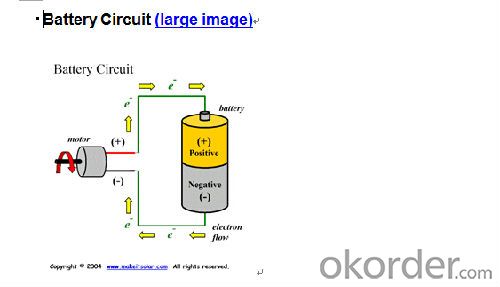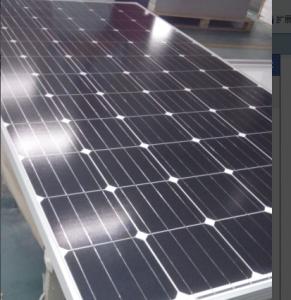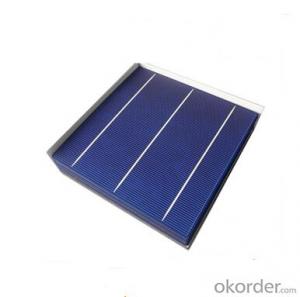High Efficiency Discount Satellite Solar Cells
- Loading Port:
- Shanghai
- Payment Terms:
- TT or LC
- Min Order Qty:
- 500 pc
- Supply Capability:
- 20000 pc/month
OKorder Service Pledge
OKorder Financial Service
You Might Also Like
| Size: | 156*156±0.5mm | Max. Power: | 3.99w | Product: | damaged solar cells |
| Pmp: | 3.99w | Vmp: | 0.516v | Imp: | 7.731A |
| Voc: | 0.621v | Isc: | 8.262A | Efficiency: | 16.25-16.50% |
| Thickness: | 190±20um | Format: | 156*156±0.5mm | FF: | 77.77% |
| Packaging & Delivery | |
| Packaging Detail: | Original Package, 100pcs in one boxes, 10boxes in one carton |
| Delivery Detail: | 1~2days |
| Specifications | |
| damaged solar cells | |
| solar cells in stock with immediate delivery with big quantity, all range cells avaiable, poly | |
Manufacturer
1,Components,ultra-white Executed tempered glass+PVB+cell+PVB+tempered glass
Glass+PVB+Cell+PVB+Glass
2,Components with ultra-white Executed tempered glass+PVB+cell+PVB+tempered glass+of PVB+tempered glass
Glass+PVB+Cell+PVB+Glass+PVB+Glass
Quality and Safety
1.Rigorous quality control meeting the highest international standards
2.High-transmissivity low-iron tempered glass, strong aluminium frame
3.Using UV-resistant silicon
4.ISO 9001:2008 and ISO 14001:2004
5.IEC61215, IEC61730, Safety Class in conformity to CE
Features
1.High conversion efficiencies resulting in superior power output performance.
2.Outstanding power output even in low light or high temperature conditions
3.Optimized design for ease of soldering and lamination
4.Long-term stability,reliability and performance
Warranties
1.10 years limited product warranty
2.15 years at 90% of the minimal rated power output
3.25 years at 80% of the minimal rated power output
Format: 156mm x 156mm
Thickness: 190um+-20um
Front(-): 1.7mm bus bars(silver),blue anti-reflecting coating(silicon nirtride)
back(+): 3mm wide soldering pads(silver) back surface field(aluminium)
| Size | 156mm x156mm ±0.5mm | |||||
| Thickness | 190um ± 20um | |||||
| Front surface(-) | 1.7mm bus bars(silver), blue anti-reflecting coating(Silicon nitride) | |||||
| Back surface (+) | 3mm wide soldering pads(silver) back surface field(Aluminum) | |||||
| TkVoltage | -0.351%/K | |||||
| TkCurrent | +0.035%/K | |||||
| TkPower | -0.47%/K | |||||
| Efficiency(%) | Pmp(W) | Vmp(V) | Imp(A) | Voc(V) | Isc(A) | FF(%) |
| 16.25-16.50 | 3.99 | 0.516 | 7.731 | 0.621 | 8.262 | 77.77 |
| 16.00-16.25 | 3.92 | 0.512 | 7.66 | 0.616 | 8.195 | 77.68 |
| 15.75-16.00 | 3.86 | 0.509 | 7.584 | 0.613 | 8.135 | 77.43 |
| 15.50-15.75 | 3.8 | 0.505 | 7.525 | 0.611 | 8.08 | 77.04 |
| 15.25-15.50 | 3.74 | 0.502 | 7.458 | 0.609 | 8.053 | 76.2 |
| 15.00-15.25 | 3.68 | 0.5 | 7.365 | 0.609 | 8.038 | 75.12 |
| 14.75-15.00 | 3.62 | 0.498 | 7.271 | 0.607 | 8.045 | 74.23 |
| 14.50-14.75 | 3.56 | 0.497 | 7.16 | 0.604 | 8.04 | 73.3 |
| 14.25-14.50 | 3.5 | 0.494 | 7.091 | 0.603 | 8.08 | 71.84 |
| 14.00-14.25 | 3.44 | 0.494 | 6.96 | 0.601 | 8.065 | 70.91 |
solar cell Pic. and drawing:

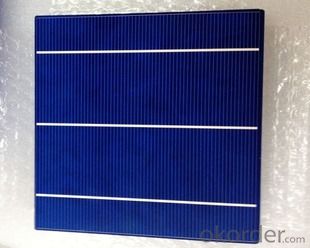
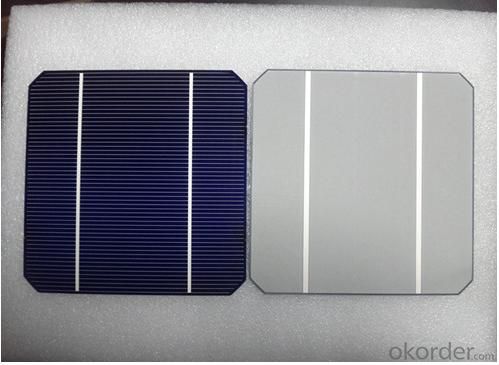
Benefits of Solar Power:
Now is a great time to go solar and harvest the power of the sun. Here is our top ten list of the benefits to installing solar power:
1, When installed, solar energy is free – no resources are consumed
2, Help to lessen our dependence on heavily polluting coal power stations
3, Fossil fuels can't last forever, future generations will appreciate the effort
4, You are gaining energy independence - add battery backup power for even greater energy security
5, The cost of electricity is only going to rise – insure against that rising cost
6, Quality solar power and water adds value and appeal to your home
7, Solar PV systems are easily upgraded in future - aim to make your house a net energy producer!
8, Solar panels offer a long lifetime of low maintenance service, maybe 30-40 years
9, Your friends will think you're great!
10, You'll feel great for doing your bit for the environment!
FAQ
1, What’s price per product ?
A: It’s depends on the quantity, delivery date and payment terms of the order. We can talk further about the detail price issue. Our products is high quality with lower price level.
2, How to make payment?
We accept T/T or L/C.
3, What is your lead time?
Generally 1-5 weeks depends on the order quantity and your specific requirements.
4, Can you do OEM for us?
Yes, we can.
5, How do you pack your products?
We have rich experience on how to pack the panels to make sure the safety on shipment when it arrives at the destination.
Some basic information about solar cell
Solar cells are devices which convert solar light energy directly into electricity and function by the photovoltaic effect. Photo- means light and -voltaic means electrical current or electricity (light-electricity). A solar cell provides direct current (DC) electricity that can be used to power DC motors and light bulbs among other things. Solar cells can even be used to charge rechargeable batteries so that electricity can be stored for later use when the sun is not available. The fully charged batteries are portable energy that can be used whenever and wherever they are needed.
Solar cells provide DC electricity similar to batteries however, batteries differ because they operate through a process known as an electrochemical reaction. This process will provide an electrical current (electro-) from a chemical reaction (-chemical) that occurs inside the battery. When you hook up a motor to the battery, also known as a load, the reaction begins and electrons flow as shown in the picture: "Battery Circuit". Direct current (DC electricity) is different from the alternating current (AC electricity) that is used to power the TV, refrigerator, and other appliances in your home however, DC can be converted to AC when needed.
Battery Circuit (large image)
Solar cells produce DC electricity from light. Sunlight contains packets of energy called photons that can be converted directly into electrical energy. You can’t see the photons but they hit the cell and produce free electrons that move through the wires and cause an electrical current as shown in the picture: "Solar Cell Circuit". The electrical current is the electricity that powers the motor. Although you can't see the photons you can see the light and you can assume that the amount of photons hitting your solar cell is related to the amount of light hitting your solar cell. A greater amount of light available means a greater amount of photons are hitting your solar cell and the more power you get from it.
Main technical parameters about solar cells
Cell Thickness
An optimum silicon solar cell with light trapping and very good surface passivation is about 100 µm thick. However, thickness between 200 and 500µm are typically used, partly for practical issues such as making and handling thin wafers, and partly for surface passivation reasons.
Doping of Base
A higher base doping leads to a higher Voc and lower resistance, but higher levels of doping result in damage to the crystal.
Reflection Control
(front surface typically textured)
The front surface is textured to increase the amount of light coupled into the cell.
Emitter Dopant
N-type silicon has a higher surface quality than p-type silicon so it is placed at the front of the cell where most of the light is absorbed. Thus the top of the cell is the negative terminal and the rear of the cell is the positive terminal.
Emitter Thickness
A large fraction of light is absorbed close to the front surface. By making the front layer very thin, a large fraction of the carriers generated by the incoming light are created within a diffusion length of the p-n junction.
Doping Level of Emitter
The front junction is doped to a level sufficient to conduct away the generated electricity without resistive loses. However, excessive levels of doping reduces the material's quality to the extent that carriers recombine before reaching the junction.
Grid Pattern.
The resistivity of silicon is too high to conduct away all the current generated, so a lower resistivity metal grid is placed on the surface to conduct away the current. The metal grid shades the cell from the incoming light so there is a compromise between light collection and resistance of the metal grid.
Rear Contact.
The rear contact is much less important than the front contact since it is much further away from the junction and does not need to be transparent. The design of the rear contact is becoming increasingly important as overall efficiency increases and the cells become thinner.
- Q: What is the most common type of solar cell?
- The most common type of solar cell is the crystalline silicon solar cell.
- Q: Are solar cells affected by electromagnetic interference?
- Yes, solar cells can be affected by electromagnetic interference (EMI). EMI refers to the disturbance caused by electromagnetic radiation on electronic devices, including solar cells. The interference can lead to reduced efficiency and performance of the solar cells. Shielding techniques and proper grounding can be employed to mitigate the impact of EMI on solar cells.
- Q: Can solar cells be used in countries with limited sunlight?
- Yes, solar cells can still be used in countries with limited sunlight. While solar cells generate the most electricity under direct sunlight, they can still generate power even in cloudy or overcast conditions. Additionally, advancements in solar panel technology have made them more efficient in capturing diffuse sunlight, enabling their use in regions with limited sunlight.
- Q: What is the impact of bird droppings on solar cell performance?
- Bird droppings have a negative impact on solar cell performance as they can obstruct sunlight and reduce the amount of energy produced by the cells. Additionally, the droppings can cause corrosion and damage to the surface of the cells, leading to further efficiency losses over time. Regular cleaning and maintenance are necessary to mitigate these effects and ensure optimal solar cell performance.
- Q: What is the impact of solar cells on job creation?
- Solar cells have had a significant positive impact on job creation. The rapid growth of the solar industry has created numerous job opportunities across various sectors, including manufacturing, installation, and maintenance. This has not only boosted employment rates but also led to the development of specialized skills and the creation of new businesses. Moreover, the shift towards renewable energy sources like solar power has the potential to further drive job creation as the demand for clean energy continues to increase.
- Q: Can solar cells be used for wireless communication devices?
- Yes, solar cells can be used for wireless communication devices. Solar cells convert sunlight into electrical energy, which can power various devices including wireless communication devices such as smartphones, tablets, or even Wi-Fi routers. This enables the devices to operate without relying on traditional power sources, making them more flexible and sustainable.
- Q: How do solar cells perform in dry desert conditions?
- Solar cells perform exceptionally well in dry desert conditions. The intense sunlight and lack of moisture in deserts create ideal conditions for solar energy generation. The absence of clouds and high temperatures enhance the efficiency of solar cells, allowing them to produce more electricity. Additionally, the dry conditions minimize the risk of corrosion and dust accumulation, which can further improve the performance and lifespan of solar panels.
- Q: I would like to use a ppt to show how solar cells can work in a power generation factory, can anybody share some useful information with me?
- The idea behind solar cells is we basically using the free electricity from the sun.
- Q: What is the internal structure of solar panels
- In addition to the quality of EVA itself, the components of the manufacturers of the laminated process is also very large, such as EVA glue degree is not up to standard, EVA and tempered glass, backplane bonding strength is not enough, will cause EVA early aging, Affect component life.
- Q: How does solar cell technology apply to our daily life?
- Nowadays, people use solar cells to generate electricity which is used in a lot of houses.
Send your message to us
High Efficiency Discount Satellite Solar Cells
- Loading Port:
- Shanghai
- Payment Terms:
- TT or LC
- Min Order Qty:
- 500 pc
- Supply Capability:
- 20000 pc/month
OKorder Service Pledge
OKorder Financial Service
Similar products
Hot products
Hot Searches
Related keywords
